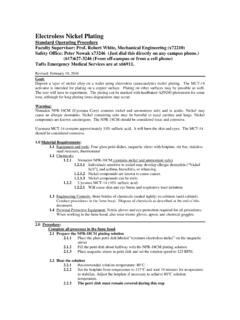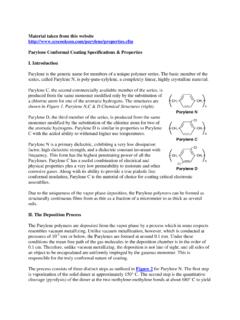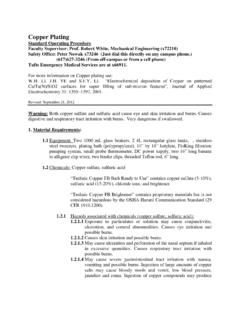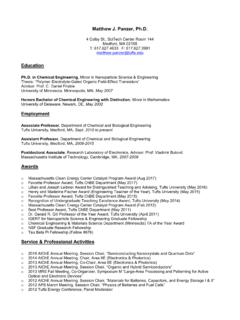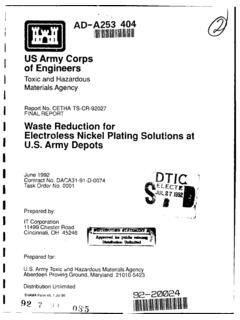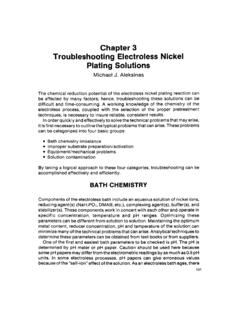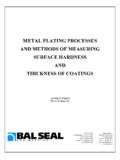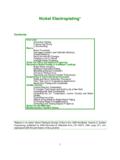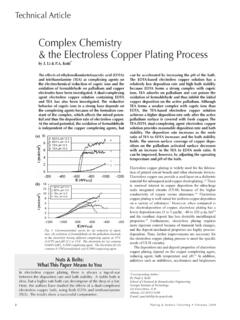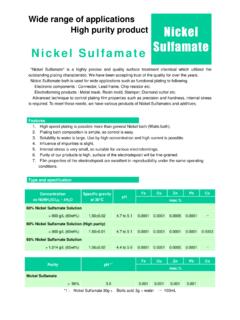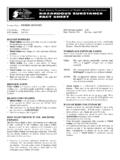Transcription of Nickel Plating (Nickel Sulfamate Plating Process)
1 Nickel Plating ( Nickel Sulfamate Plating process ) Standard Operating Procedure Faculty Supervisor: Prof. Robert White, Mechanical Engineering (x72210) Safety Office: Peter Nowak x73246 (Just dial this directly on any campus phone.) (617)627-3246 (From off-campus or from a cell phone) Tufts Emergency Medical Services are at x66911. Revised: September 20, 2012 Warning: Nickel Sulfamate is known to cause cancer if inhaled or ingested. For this reason we do NOT mix our own Nickel Plating solution, but purchase it already mixed to reduce any chance of inhalation of Nickel Sulfamate powder. Nickel Sulfamate , Nickel bromide, and boric acid solution cause slight irritation to the nasal and respiratory passages, minor skin irritation ( Nickel Itch ) and burns to the eyes.
2 If swallowed, will cause irritation to the mouth and throat, nausea, vomiting, and diarrhea. 1. Material Requirements: Equipment: Two 1000 mL glass beakers, 2 4L rectangular glass tanks, , stainless steel tweezers, Plating bath (polypropylene), 10 by 10 hotplate, FloKing filtration pumping system, small probe thermometer, DC power supply, two 16 long banana to alligator clip wires, two binder clips, threaded Teflon rod, 6 long Chemicals: Technic Nickel Sulfamate Semi-bright Ready to Use contains Nickel Sulfamate (20-35%), Nickel bromide ( ), and boric acid (1-3%). Hazards associated with chemicals ( Nickel Sulfamate , Nickel bromide, boric acid): Individuals sensitive to Nickel may develop allergic dermatitis ( Nickel Itch ), and asthma, bronchitis, or wheezing.
3 Nickel compounds are known to cause cancer. Engineering Controls: Store bottles of chemicals (sealed tightly) in cabinets (acid cabinet) with secondary containment. Work area should contain an eye wash and safety shower. All chemical processing should occur in the chemistry fume hood. Personal Protective Equipment: Trionic gloves on top of nitrile gloves, and goggles. Procedure: Complete all processes in the fume hood Seed Layer Deposition Deposit (using sputtering or evaporation) a seed layer consisting of 20 nm of Ti and 100 nm of Cu onto your wafer. Other metals and thickness will also work as seed layers. Cr/Au 50 nm/300 nm has been tested and also works fine.
4 Some differences in results may be observed for different seed layers. The Nickel will plate only onto the seed layer, so if you pattern the seed layer before Plating you will end up with patterned thick Nickel . Note that there must be a continuous electrical connection between the seed layer and the cathode during Plating , so if you leave any unconnected islands of seed layer on your wafer they will plate much more slowly than the rest of the wafer. Prepare the Technic Ready to Use Nickel Sulfamate semi-bright Plating solution (Note: this is truly ready to use .. it has all the necessary components, and has already been balanced by the manufacturer.)
5 It is likely that there is already a 4L rectangular tank with Nickel Plating solution in it, in the acid hood, labeled as Nickel Plating Solution. Use this if it is already there. Do NOT fill the tank to the fill line yet. The tank should be filled to the fill line only AFTER the filtration pump is in place (this will be discussed below). If a new tank is needed, fill the tank with Ready to Use Nickel Sulfamate (semi-bright, mechanical agitation) from Technic. Heat the Solution For Nickel Plating , 50 oC solution temperature is recommended. Place the Plating tank on the 10 x 10 hotplate (carefully!). Remove the aluminum foil and Parafilm cover.
6 Put the plastic cover on with the angled hole, and put the small battery powered probe thermometer through the hole so that the probe pokes into the solution. Set the hotplate front temperature to 200 oC and wait for hours. Reduce hotplate temperature to 160 oC. The solution temperature should stabilize at 50 oC. Adjust the hotplate by small amounts if necessary to achieve 50 oC solution temperature AT NO TIME SET THE HOTPLATE TO HIGHER THAN 200oC. IF THE HOTPLATE IS SET TOO HIGH THE GLASS TANK MAY CRACK AND THE SOLUTION ALL COME SPILLING OUT. THIS HAS HAPPENED. Setting up the Filtration Pump Remove the FloKing filtration pump body from the water soak where it is stored.
7 It should not yet have a filter on it. You should see the filter cylinder floating in the Nickel Plating tank (it is stored in there so it is always soaked with Nickel Plating solution). Lift the filter gently part way up and at an angle with your tweezers, so that you can slide the filter pump down into the center of the filter. Note that one side of the filter is closed with a plug, only one side will be open, make sure it is the right way around. Hang the filter pump body on the back of the tank using the clamp. Once the filter is in place, check the level of the Nickel Plating solution. It should come up to the line marked on the side of the tank, so it is below the motor portion of the pump, but above the branch for the Y shaped tube.
8 If necessary, add some Nickel Plating solution from the ready to use bottle to bring the solution level up to the marked fill line. Plug in the filter. You should see gentle recirculation of the solution. It is being mixed and actively filtered. This is critical to achieve a smooth and particle- free film. Nickel Plating Perform these steps in the Chemistry Fume Hood. Fill two water rinse beakers which will fit your samples (1000 mL beakers). Do this first. If something goes wrong, you want the water available to quench the reaction. Fill the 1000 mL beakers with deionized water. A strip of pure Nickel sheet or foil will be used as an anode. It is recommended to use an anode that is approximately the size of the total sample size to maintain a more uniform current density.
9 For a 4 diameter wafer, use a piece approximately 3 wide and 5 long. Make sure this is do not use an old one if it looks tarnished. A binder clip works well to hold\ the wafer. Attach the binder clip to the wafer so that the wafer hangs down from the binder clip. Attach the second binder clip to the Nickel anode. Hang the wafer and the Nickel anode from the Teflon threaded rod, with the surface to be plated facing the Nickel anode. Hang the two so they are approximately 1 inch apart, and parallel. Immerse the cathode and anode in the solution. The top edge of the wafer and top edge of the Nickel should poke out above the surface a little bit. Attach the alligator clips to the anode and cathode.
10 Note that it is critical that there is a place for the alligator clip to attach to the wafer that is not coated with photoresist! You need a good contact region to make connection to the seed layer. This should be designed in as part of your mask, otherwise you may been to try to use acetone on a swab to open up a little region at the edge of the wafer to make contact. Make sure the electrical connection to the power supply is the right way around!!! Negative terminal (cathode): wafer, Positive terminal (anode): Nickel plate. The completed set up should look similar to the picture below. Decide what current you want to operate at. It is recommended that you operate at 5 mA/cm2 of Plating current density at the cathode in order to produce a smooth film.
